City of Elk Grove - Design Guides Phases
REF:
Chapter 3A
Page #15, Doc. Page 32
7) In order to ensure safe and convenient pedestrian street crossings, one of the following design
improvements listed below, or a combination thereof, shall be incorporated...
c) Innovative use of paint striping and pattern, signage, and/or lighting to delineate crossings;
Page #18, Doc. Page 35
The pedestrian connection shall be improved with enhanced landscaping and security lighting.
Page #27, Doc. Page 44
23) Street lighting along local residential streets shall be designed at a pedestrian Scale with a maximum
height of 14 feet (see Photos III-36 and III-37).
This section provides fine examples of truly bad light fixtures.
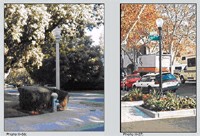
Chapter 3B
While this section does not contain any lighting guides it does contain examples of bad lighting.
Also Title 24 the building energy code requires motion sensor exterior lighting on all new homes.
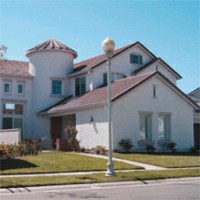 Photo III-47: |
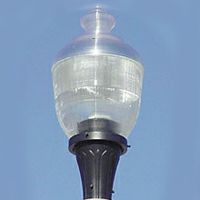 A Gross
Polluter
|
Photo
III-47: Represents
one of the most offensive fixture in in common use. These
fixtures should only be used in historic districts and only fixtures
which qualify as full cutoff. Many other decorative style
fixtures are available. See for examples. See also Skykeepers Lighting Examples. |
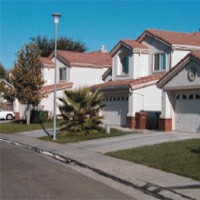 Photo III-80: |
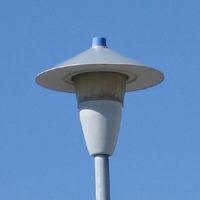 A Gross
Polluter
|
Photo III-80: Represents one of the
most offensive fixture in in common use. These fixtures
should never be used. They produce considerable uplight and
glare. Light from these two fixtures can degrade the nights sky
hundreds of miles away. See for examples. Lighting Examples. |
Please see Good and Bad Lighting in the Central Valley for examples of major contributors to Light Pollution in the Central Valley?
Chapter 4A
Page #3, Doc. Page 74
2. Design Guidelines
... Zoning Code development standards for multi-family residential projects address building setbacks, height, parking, landscape and lighting. ...
Page #16, Doc. Page 87
Lighting of Parking Areas, Drive Aisles, and Pedestrian Walkways
Site lighting for multi-family projects include lighting of project entries, drive aisles and parking areas, pedestrian
walkways, and common areas designated for regular nighttime use. This lighting is important for safety reasons
and for the architectural enhancement of the development. Building lighting guidelines are listed in the
architecture section.
24) Exterior lighting shall be pedestrian in scale with a maximum height of 14 feet.
25) Exterior site lighting shall be designed so that light is not directed off the site and the light source is
shielded downward from direct off-site viewing. Specifically, light features shall be located and
designed with cut-off lenses to avoid light spill and glare on adjacent properties. In order to minimize
light trespass on residential properties directly abutting a multi-family site, illumination measured at the
nearest residential property line shall not exceed the moon’s potential ambient illumination of one-tenth
(0.1) foot-candle.
Page #17, Doc. Page 88
26) The City encourages use of low-level bollard lighting for illumination of pedestrian walkways
(see Photo IV-18).
27) Outdoor light fixtures used to illuminate architectural and landscape features shall use a narrow cone
of light for the purpose of confining the light to the object of interest and minimize light trespass and
glare.
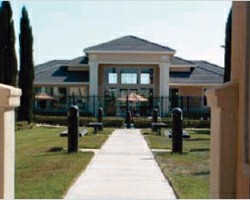 |
Photo IV-18: Bollard
lighting is used to illuminate a pedestrian walkway within this
multi-family project. Bollard lighting is often an excellent choice as it puts light near the ground where it is needed. While reflected light provides adequate vertical illumination for security. |
Chapter 4B
Page #9, Doc. Page 98
Building Lighting
18) All exterior building attached lighting shall be located to a pedestrian scale and be designed so that
light is not directed off the site and the light source is shielded downward from direct off site viewing.
19) All exterior building lighting shall be architecturally integrated with the building style, materials, and
colors (see Photo IV-29 on next page).
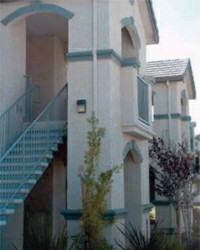 |
Photo IV-29: The exterior building
lighting for this project is architecturally integrated into the building design. This is clearly not a good fixture to use for this or any application. A cheep wall pack can hardly be described as "integrated with the building style, materials". This wall pack is clearly detrimental to the vision of residents assenting the stairs. Any unshielded fixture mounted on a second story creates light trespass and sky glow. Wall Packs are a major contributer to Light Pollution. |
Page #10, Doc. Page 99
Photo IV-29: The exterior building lighting for
this project is architecturally integrated into the
building design
Unit Entries
20) Provide clearly defi ned site and building entries that are in Scale with the proposed project and relate
directly to the street frontage. The front door to each unit should be clearly visible. These entries to
units should be clearly identifi ed, protected from weather and provided with lighting for nighttime
safety and security. Additionally, the entrances to individual units should be plainly visible from the
nearby parking areas. The use of distinctive architectural elements and materials to denote prominent
entrances is required (see Photos IV-30 and IV-31).
Chapter 5A
Chapter 5A - Site Planning for Non-Residential Development
http://www.egplanning.org/projects/design_guidelines/documents/Pages%20from%20DG-chapter_5A.pdf
Page #3, Doc. Page 104
2. Design Guidelines for All Non-Residential Development
Site Planning
... Site design must adhere to
the development standards set forth in the Zoning Code in regard to allowed uses, setbacks, landscaping,
parking, and lighting. ...
Page #23, Doc. Page 124
Lighting of Parking Areas, Drives, and Pedestrian Walkways.
Exterior lighting includes streetlights and lighted walkways within a non-residential development project. This
lighting is important for safety reasons and for the architectural enhancement of the development. See
additional lighting provisions in the architecture section of the guidelines for non-residential development.
37) Exterior site lighting shall be designed so that light is not directed off the site and the light source is
shielded downward from direct off-site viewing.
38) Exterior lighting shall be architecturally integrated with the building style, material and colors and be
of a human Scale (refer again to Photos V-3 and V-4).
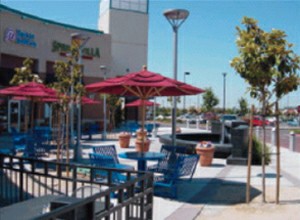 |
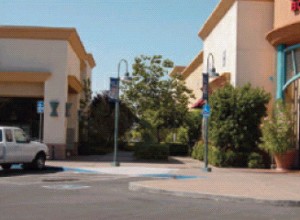 |
| Photo V-3: Outdoor seating area Laguna Gateway with site furniture including tables, umbrellas, and decorative pots. These fixtures may be appropriate but are not fully shielded, allow uplight and contribute to sky glow. |
Photo V-4: Pedestrian connection between multitenant buildings along Laguna Boulevard to a commercial center in Elk Grove. These fixtures are most appropriate and fully shielded. |
Page #24, Doc. Page 125
39) Light features shall be located and designed with cut-off lenses to avoid light spill and glare on adjacent
properties. In order to minimize light trespass on residential structures directly abutting a non-residential
site, illumination measured at the nearest residential structure or rear yard/side yard setback line shall
not exceed the moons potential ambient illumination of one-tenth (0.1) foot-candle. This measurement
is not taken at the property line, but at the nearest location of a residential structure (required rear
yard or side yard setback line).
40) Except as otherwise exempt, all outdoor lighting for non-residential development shall be constructed
with full shielding. Where the light source from an outdoor light fi xture is visible beyond the property
line, shielding shall be required to reduce glare so that the light source is not visible from within any
existing or future residential dwelling unit.
41) Outdoor light fi xtures used to illuminate architectural or landscape features should use a narrow
cone of light for the purpose of confi ning the light to the object of interest and minimize light
trespass and glare. Appropriate level of illumination will be determined during the required design
review.
Chapter 5B
Chapter 5B - Architecture for Non-Residential Development
REF: http://www.egplanning.org/projects/design_guidelines/documents/Pages%20from%20DG-chapter_5B.pdf
architecture for non-residential development
Page #3, Doc. Page 142
B. ARCHITECTURE FOR NON-RESIDENTIAL DEVELOPMENT
3) Buildings should be designed with careful consideration for the incorporation of signage and lighting. New
buildings and additions shall be designed to allow for signs appropriate in scale and location to the use
and the neighborhood.
Page #10, Doc. Page 149
Building Lighting
17) All exterior building lighting shall be located to a human scale.
Page #11, Doc. Page 150
18) Exterior building and site lighting shall be designed so that light is not directed off site and the light
source is shielded downward from direct off-site viewing. However, the designated Approving Authority
for Design Review may approve building-attached lighting that is not shielded downward with the
determination that the light fi xture is compatible with the building design and the level of illumination
is evaluated for potential impacts (see Photo V-56).
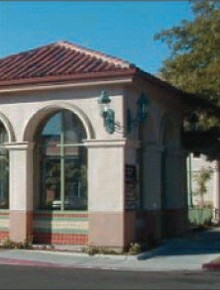 |
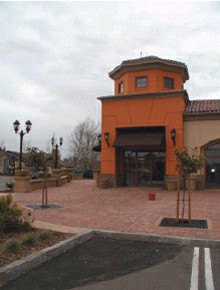 |
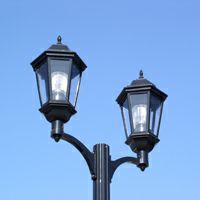 In this case hight output Metal Halide
coupled with a refractive element make for considerable glare and up
light. In this case hight output Metal Halide
coupled with a refractive element make for considerable glare and up
light.A Gross
Polluter.
|
| Photo V-56: This photo shows exterior building lighting that is compatible with the design of the project. |
Photo V-57: Both freestanding and buildingattached lighting in this development complement the architectural style of the project. | Unfortinately these two examples may
very well represent the very bad lighting as show above. |
19) Exterior lighting can detract from or add to the architectural design and quality of the building. All
exterior lighting shall be architecturally integrated with the building style, material and colors. The City
discourages the up-lighting or back-lighting of canopies or awnings and prohibits the use of neon tubing
or band lighting along building facades or cornices. However, lighting used to accent an architectural
feature or design attribute may be approved in conjunction with Design Review (see Photo V-57).
Page #13, Doc. Page 152
Photo V-58: The pad building (right) has design features (such as
building form and colors, facade and detailing, window shapes,
and lighting) that are consistent with the architecture of the
overall development (left).
Page #3, Doc. Page 162
D. Location
Outdoor art should be positioned in a well-lit place with lighting designed to illuminate the
piece and not produce unnecessary light spillover onto adjacent residential properties.
Comments:
This design guide marks a very good effort to reduce Light Trespass and Glare but fall short in preventing "Urban Sky Glow".
To "avoid light spill and glare on adjacent properties" is wonderful however it does not protect the Dear Creek Hills to the east, Stone Lake Wildlife Preserve to the west, Cosumnes River Preserve to the south, or American River Parkway to the north.
"Exterior building and site lighting shall be designed so that light is not directed off site" can and should be interpreted as no spill light beyond the property on which the light originates.
Light Trespass is established as -
"illumination measured at the nearest residential structure or rear yard/side yard setback line shall not exceed the moons potential ambient illumination"
This is an excellent way of defining Light Trespass in a suburban or rural setting.
However Deep Twilight = 0.1 fc and the Full Moon = 0.01fc are the accepted values.
Light Trespass not exceeding 0.01fc after curfew hours should be considered a standard.
It is similar to and in some ways superior to the idea in the Yocca Valley Ordinance, San Bernardino County -
(h) "Light Trespass" means nuisance glare from any lighting onto neighboring property that interferes with viewing of night sky or eliminates the ability to have darkness on the adjacent property or shines into neighboring windows and all or any areas on neighboring properties or structures. Quantitative measurement of light trespass shall be with a standard yard stick (3 ft x 1.5 in.). The yard stick shall be placed at the building setback line in the complainants yard. The yard stick shall be in contact with the ground and in a vertical position. The enforcement personnel shall than determine if a shadow is cast by the light source. The light source, yard stick, and shadow must be in alignment. Measurements shall not be taken when there is a moon in the night sky.